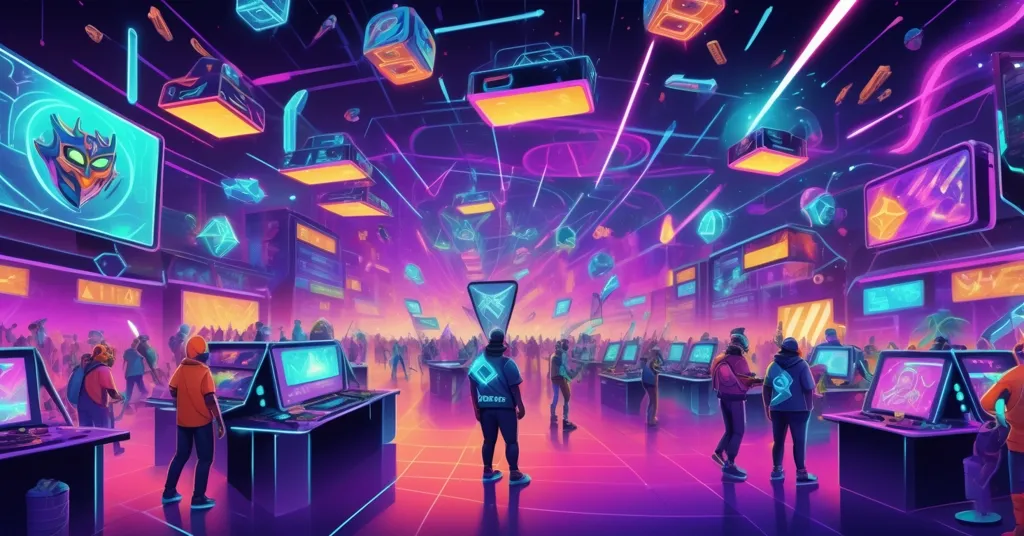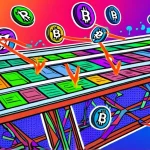Rarible Integrates Somnia Blockchain: A Bold Step for NFT Gaming in 2025

Rarible’s Bold Leap with Somnia Blockchain: A Game-Changer for NFT Gaming?
Rarible, a powerhouse in the multi-chain NFT marketplace scene, has made waves by integrating the Somnia blockchain network on July 31, 2025. This move, rolled out on RaribleFUN, lets users mint, trade, and collect NFTs tied to Somnia’s high-speed, gaming-focused Web3 ecosystem, signaling a calculated push into one of crypto’s hottest niches.
- Major Move: Rarible adds Somnia support, featuring NFT collections like Netherak Demon and Mask of the Void.
- Launch Perk: Somnia offers a free NFT drop with over 50 ecosystem-inspired artworks to celebrate.
- Market Heat: NFT sales jumped 48% in July 2025, making this partnership a timely bet on renewed interest.
Rarible’s Expanding Empire
Rarible has been a heavy hitter since bursting onto the scene in 2021, riding the NFT bull run to rack up over 2 million users at its peak. It’s not just a marketplace; it’s a creator’s haven, offering easy minting, customizable royalties, and auction formats that let artists and collectors call the shots. With governance powered by the RARI token, it embodies the decentralization ethos we champion. Already supporting major chains like Ethereum, Solana, Polygon, Tezos, and Immutable X, Rarible’s addition of Somnia brings its blockchain count to six. This isn’t a random grab for relevance—it’s a strategic pivot to capture the growing hunger for interactive, gaming-driven NFTs via RaribleFUN, its dynamic trading hub, as detailed in the recent Rarible and Somnia partnership announcement.
Since its heyday, Rarible has empowered countless creators, dishing out significant royalty payouts—think millions in earnings for artists who’d otherwise be nickel-and-dimed by traditional platforms. Compared to juggernauts like OpenSea, which still dominates market share, Rarible’s multi-chain strategy offers a flexibility that’s paid off in loyal users, even if it hasn’t always translated to raw volume. Adding Somnia is a gamble to keep that edge, but managing six chains is a real headache—different fees, interfaces, and quirks could trip up newcomers or annoy veterans looking for simplicity.
Somnia’s Gaming Gambit: Speed Meets Scale
So, what’s Somnia all about? It’s not just another alt-chain hyped for clicks. This blockchain is built for speed and scale, zeroing in on gaming, social platforms, and metaverse projects. Being EVM-compatible—meaning it can run apps and tools designed for Ethereum—Somnia lowers the barrier for developers already fluent in Eth’s ecosystem. Its big pitch? Handling over 1 million transactions per second (TPS) with sub-second finality (transactions confirm faster than you can snap your fingers) at costs reportedly less than a penny. That’s Web2-level slickness in a Web3 package, a far cry from Ethereum’s gas fee gut-punches or Bitcoin’s leisurely settlement times, as explored in this technical breakdown of Somnia’s blockchain.
For gamers and creators, this could be huge. Imagine trading in-game assets—swords, skins, or virtual land—as NFTs without waiting minutes or shelling out bucks per click. Somnia’s collections like Maelstrom, Dark Table, and QRusader, now live on RaribleFUN, hint at a dark, immersive aesthetic tailored for gaming lore. To top it off, Somnia’s rolled out a free open edition NFT set with over 50 pieces reflecting its ecosystem—a digital loot box for early adopters. Beyond NFTs, Somnia’s got 14 dApps in its arsenal, spanning gaming, DeFi, AI, and metaverse sectors. Think Playground, a web-based metaverse, or Lucky Adventurer’s Gambit, an on-chain RPG with tradable assets. Even Sogni AI, blending image generation with rewards, shows Somnia’s not playing small ball—it’s aiming to be a full Web3 playground, with unique features and inherent risks worth considering.
Market Timing: Riding the NFT Resurgence
Let’s zoom out to the bigger picture. The NFT market is clawing back relevance, with sales spiking 48% in July 2025 over June. Specific collections like Solana’s Lil Chiller saw daily volumes soar by 1,000%, proof that the hunger for digital assets isn’t dead—it’s evolving. Beyond static jpegs, users crave utility: interactive assets tied to games or virtual worlds. Web3 gaming alone is ballooning—revenue projections hit billions last year, per industry trackers like DappRadar, as players demand ownership over their digital haul. Rarible’s tie-up with Somnia isn’t just timely; it’s a bet on gaming as the trojan horse for mass crypto adoption, aligning with current NFT market trends showing a gaming focus. Picture a small indie dev minting in-game gear for pennies on Somnia and reaching Rarible’s vast audience—that’s the kind of disruption we’re rooting for.
Risks on the Horizon: Hype vs. Reality
But here’s the catch—don’t pop the champagne just yet. Somnia’s claims of 1 million TPS and dirt-cheap fees sound like they’re promising to outrun Usain Bolt. Impressive? Sure. Proven? Not even close. As of the latest updates, much of Somnia’s ecosystem is still in testnet—a testing phase before full launch—meaning real-world stress tests are pending. We’ve seen this movie before: Solana’s outages in 2021-2022, EOS’s grand promises fizzling, Cardano’s endless delays. Bold specs on paper don’t mean jack if the network chokes under load. Can Somnia deliver when thousands of gamers hammer it with trades mid-battle? That’s the million-dollar question, and expert analyses on Somnia’s scalability claims raise similar concerns.
Rarible’s got its own tightrope to walk. Supporting six blockchains is inclusive, but it risks turning the platform into a bloated mess. Newbies might balk at navigating chain-specific quirks—Ethereum’s fees, Solana’s wallets, now Somnia’s untested waters. Even OGs could wonder if Somnia’s just another flavor-of-the-month chain hyped by insiders. Then there’s the NFT cesspool of fraud—gaming assets are ripe for wash trading, where rare items get artificially pumped. Rarible’s got to play sheriff to keep Somnia collections clean, or this partnership could backfire as a scammer’s paradise. On the flip side, industry voices like Somnia founder Paul Thomas are doubling down with confidence:
“This is just the beginning. Fully on-chain applications are happening now.”
Thomas insists Somnia proves on-chain apps aren’t a pipe dream—they’re live. Infectious optimism, but I’m holding out for hard data over hot air.
Competitive Heat: Somnia in the Arena
Somnia isn’t stepping into an empty ring—it’s up against heavyweights like Solana and Avalanche, both gunning for the high-throughput crown. Solana’s already clocking thousands of TPS with a thriving gaming scene, despite past hiccups, while Avalanche boasts subnets tailored for apps like metaverses. Somnia’s edge—on paper—is its sub-penny costs and laser focus on Web3 gaming experiences, a topic worth exploring through discussions on blockchain in Web3 gaming. But standing out takes more than claims; it demands flawless execution and user buy-in. If Somnia stumbles on mainnet, Rarible’s bet could look like a misstep in a crowded field. Still, its open-source tools like Metaverse Markup Language (MML) might lure devs looking to build without breaking the bank, giving it a fighting chance.
A Win for Decentralization?
From a decentralization and innovation standpoint, I’m cheering this on. Rarible’s creator-first toolkit—flexible royalties, no middlemen—mirrors our fight against gatekeepers. Somnia’s ecosystem, if it delivers, could onboard non-crypto natives who don’t care about Bitcoin’s ideology but will dive in if a game feels seamless and fun. As a Bitcoin diehard, I’ll always see BTC as the gold standard for sound money, a rock in a sea of speculative alt-coins. But I’ll concede Somnia might power the arcade of the future—Bitcoin isn’t built for sub-second NFT trades or dynamic game mechanics. Specialized chains fill gaps BTC shouldn’t touch, and under the effective accelerationism mindset, I’m all for building fast, breaking stuff, and iterating toward mass adoption.
We’ve seen NFT mania before—millions poured into pixelated apes in 2021, only for 90% to tank. Somnia’s gaming angle feels different, but skepticism is warranted. Success hinges on execution: Somnia must nail mainnet without glitches, and Rarible needs to keep its platform tight, not a sprawling mess of chains. For now, users can snag a free Somnia NFT drop—a quirky memento that might be a collector’s gem or just a funny footnote, with more insights available on Rarible’s support for Somnia NFTs.
What’s Next for Rarible and Somnia?
Looking ahead, if Somnia hits mainnet without a hitch, could Rarible become the Steam of Web3 gaming—a one-stop shop for on-chain assets? Or will it be another overhyped experiment in the chaotic NFT saga? The potential for smaller creators and gamers to jump in—priced out elsewhere by fees—is tantalizing. But past blockchain busts remind us to temper excitement with a critical eye. This partnership is a microcosm of where decentralized tech is headed: specialized chains tackling niche pain points, marketplaces casting wide nets, and the relentless push to rival Web2’s polish. We’re rooting for disruption over stagnation, but only time will tell if this bet pays off. For further context, check out community opinions on Rarible’s integrations and NFT gaming.
Key Questions and Takeaways on Rarible and Somnia’s NFT Partnership
- What does Rarible’s Somnia integration mean for NFT users?
It opens access to gaming-focused Somnia NFTs on RaribleFUN, giving creators and collectors fresh options in a resurging market. - Why is Somnia’s tech crucial for Web3 gaming?
Its claimed 1 million TPS and sub-second finality could enable instant, low-cost in-game NFT trades, matching traditional gaming’s smoothness. - What risks loom over this partnership?
Somnia’s scalability is untested outside testnet, and Rarible risks user confusion with six blockchains, while NFT scams could taint gaming assets. - How might this fuel broader blockchain adoption?
Targeting gaming—a massive industry—could draw non-crypto users into decentralized tech via entertainment, a powerful gateway. - Do Bitcoin maximalists have reason to dismiss Somnia?
Not really—Bitcoin isn’t suited for high-speed gaming NFTs; chains like Somnia tackle niches BTC can’t, pushing the decentralization mission forward.


